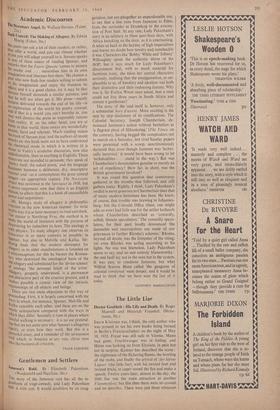Academic Discourses
The Necessary Angel. By Wallace Stevens. (Faber, 21s.) uark Conceit: The Making of Allegory. By Edwin
,13,1G poets can ask a lot of their readers; or rather, tneY offer a world, and you can choose whether Or not you will adapt yourself to it. Stevens speaks ireri one of these essays of reading Spenser, and rks that the Faerie Queene 'comes to possess 1,11e reader and . . . naturalises him in its own Imagination and liberates him there.' He chooses a 1,3°e1 vvho now finds few readers willing to submit to his imagination and enjoy the freedom he or,Ifers; and it is a good choice, for it may be that evens himself demands a similar patience, and .tnat he will not often get it. His prose—mainly lectures delivered towards the end of his life—is a" exploration of the world his poetry created: and if that is a world you can't breathe in, you En% well dismiss the prose as impossibly remote Lreiln reality. If, on the other hand, you are at "nine in that world, these essays are wonderfully Precise, lucid and relevant. Much reading makes "le book of Stevens true: and the authors of recent ,altacks on this book Seem not to have understood rhetorical mode in which it is written (it is e'nser to Valdry's academic discourses, now also unfashionable, than to anything in English). These e,ssays are not intended to persuade; they speak of „poetry itself, the naked poem,' and the language illictuates between a deliberate, dry, descriptive in)anner and—as it contemplates the great central 4Inages—an appropriate rapture. The Necessary ;,`ngel was reviewed in the Spectator in 1958. but " seems important, now that there is an English edition, to affirm that this is a book of unassailable Power and importance. ,N1r. Honig's study of allegory is philosophic .1.'1ieism in the new American manner. To write
way it is at least necessary to read and think.
he master is Northrop Frye, the method is to s,t(IIIY the world of literature with the purpose of ("seovering by induction its laws. The analogy is ,With Physics. To study allegory one ,observes its "ehaviour in as many contexts as possible; in SbPenser, but also in Melville and Kafka. Mr.
finds that the modern disrespect for "egory in its older manifestations is founded on 4 misconception; for this he blames the Roman- ti,es, who destroyed the ontological basis of the °1:1 allegory and substituted for the 'divine science' °I analogy 'the personal fetish of the artist.' Allegory, properly understood, is a permanent 'lid distinctive part of the creative process, and it Makes possible a cosmic view of the intrinsic relationships of all objects and beings.' There are two main objections to this way of Prfteeding. First, it is largely concerned with the Ys in which, for instance, Spenser, Melville and ,,,`‘Lafka resemble each other, and these are on the Whole unimportant compared with the ways in Which they differ. Secondly it runs in places where eareful walking is necessary : it is no use pretend- that we are quite sure what Spenser's allegories signify, or even how they work. But this is a PeWerfl.11 essay, and a reminder of the seriousness With which, in America at any rate, clever men ttlke the business of criticism.
I RANK KERMODE


































 Previous page
Previous page